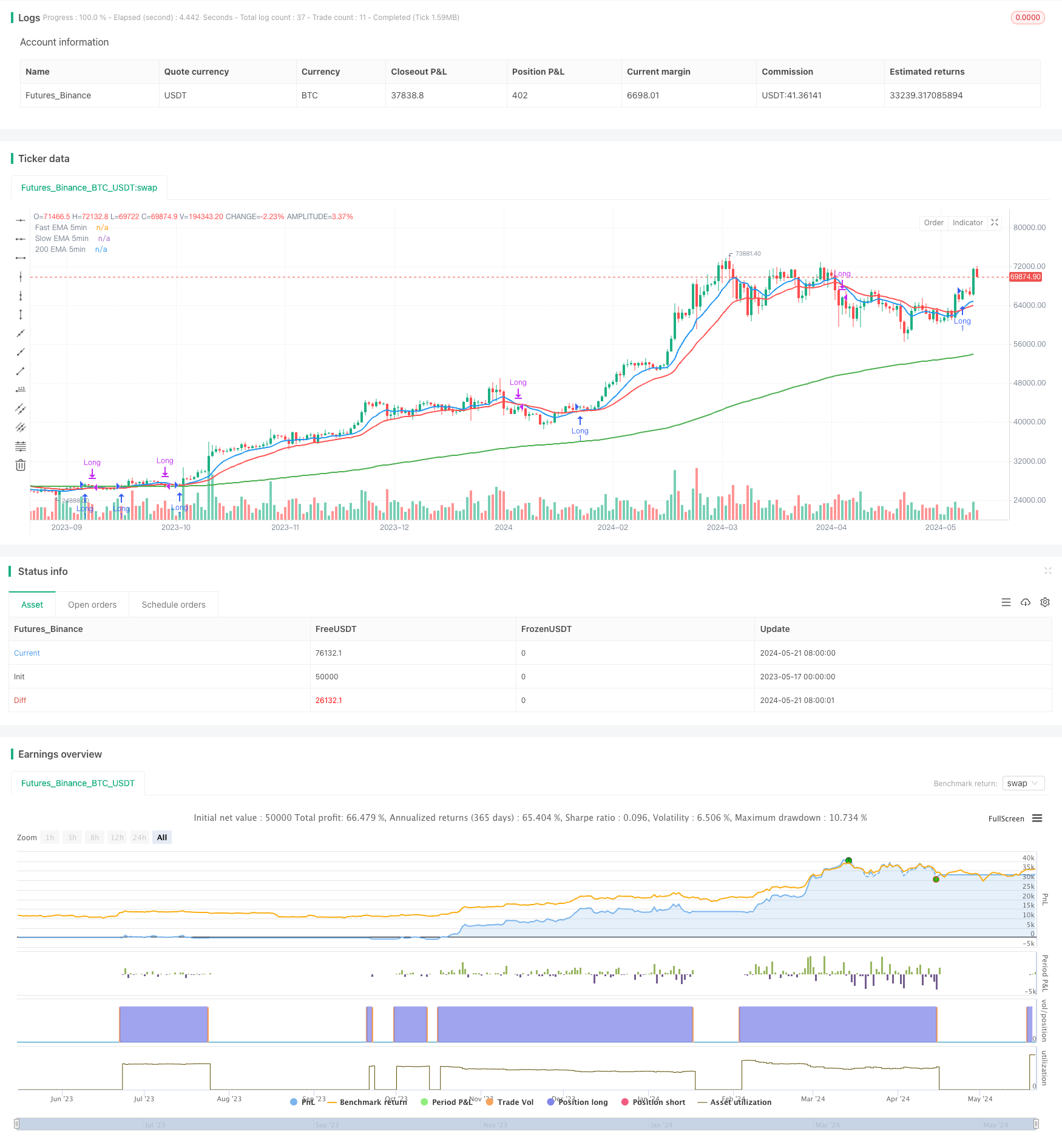
概述
该策略是一个基于多时间框架指数移动平均线(EMA)和200期EMA过滤器的趋势跟踪策略。它的主要思路是利用不同时间框架的EMA来识别市场的趋势方向,并在趋势向上且价格在200期EMA之上时建立做多头寸。这样可以确保只在强势上涨趋势中进行交易,以把握持续的上涨行情,同时利用止损和止盈机制来控制风险。
策略使用5分钟、15分钟和30分钟三个时间框架,分别计算快速EMA和慢速EMA。通过比较每个时间框架的快速EMA和慢速EMA,可以判断该时间框架的趋势方向。然后将三个时间框架的趋势信号加总,得到一个综合的趋势信号。当综合趋势信号为3(即所有时间框架都是上涨趋势)且当前收盘价在5分钟200期EMA之上时,策略开仓做多;当综合趋势信号小于3或者价格跌破5分钟200期EMA时,策略平仓。
策略原理
- 分别计算5分钟、15分钟和30分钟时间框架的快速EMA(默认9期)和慢速EMA(默认21期)。
- 在5分钟时间框架上计算200期EMA,作为趋势过滤器。
- 对每个时间框架,比较快速EMA和慢速EMA的大小,快速在上为上涨趋势(+1),慢速在上为下跌趋势(-1)。
- 将三个时间框架的趋势信号相加,得到一个区间在[-3, 3]的综合趋势信号。
- 当综合趋势信号等于3(强势上涨)且当前收盘价在5分钟200期EMA之上时,开仓做多。
- 当综合趋势信号小于3(上涨趋势减弱)或者价格跌破5分钟200期EMA时,平仓。
- 开仓时,止损设在开仓价下方1%,止盈设在开仓价上方3%。
优势分析
- 利用多个时间框架的趋势信号,可以更全面地判断市场趋势,减少假信号。
- 200期EMA过滤器能够确保只在强势上涨趋势中交易,提高成功率。
- 严格的开平仓条件和止损止盈,有助于控制风险,提高风险收益比。
- 参数可调,适用于不同市场和交易风格。
风险分析
- 在趋势转折点反应可能较慢,错失最佳建仓时机。
- 频繁开平仓可能增加交易成本。
- 止损位置固定,在波动较大的行情中可能会被提前止损出场。
- 趋势判断基于历史数据,对于突发事件引起的价格波动可能反应不及时。
优化方向
- 引入更多时间框架或者优化现有时间框架的选择,提高趋势判断的准确性和及时性。
- 对止损和止盈位置进行优化,例如引入追踪止损或者动态止盈,以适应不同的市场状况。
- 在趋势信号之外,引入其他信号如成交量、动量等,形成多因子开平仓条件,提高策略稳健性。
- 对参数进行优化,找到最适合当前市场的参数组合。
- 考虑加入做空机制,扩大适用范围。
总结
该策略通过多个时间框架的EMA比较来判断趋势方向,同时使用200期EMA作为趋势过滤器,在趋势明确向上且价格在长期均线之上时建立做多头寸,以把握强势上涨行情。严格的开平仓条件和固定止损止盈有助于控制风险。但是该策略在趋势转折点的反应可能较慢,且止损止盈位置固定,在应对市场突发波动时具有局限性。 未来可以通过引入更多时间框架、优化止损止盈、加入更多交易信号、参数优化等方式来提升策略的适应性和稳健性,使其能够更好地把握市场机会并控制风险。
策略源码
/*backtest
start: 2023-05-17 00:00:00
end: 2024-05-22 00:00:00
period: 1d
basePeriod: 1h
exchanges: [{"eid":"Futures_Binance","currency":"BTC_USDT"}]
*/
//@version=5
strategy("Multi-Timeframe Trend Following with 200 EMA Filter - Longs Only", shorttitle="MTF_TF_200EMA_Longs", overlay=true, initial_capital=1000, default_qty_type=strategy.fixed, default_qty_value=1)
// Inputs
fast_length = input.int(9, title="Fast EMA Length", minval=1)
slow_length = input.int(21, title="Slow EMA Length", minval=1)
filter_length_200 = input.int(200, title="200 EMA Length", minval=1)
stop_loss_perc = input.float(1.0, title="Stop Loss Percentage", minval=0.1) / 100
take_profit_perc = input.float(3.0, title="Take Profit Percentage", minval=0.1) / 100
// Calculate EMAs for 5-minute, 15-minute, and 30-minute timeframes
ema_fast_5min = request.security(syminfo.tickerid, "5", ta.ema(close, fast_length), lookahead=barmerge.lookahead_on)
ema_slow_5min = request.security(syminfo.tickerid, "5", ta.ema(close, slow_length), lookahead=barmerge.lookahead_on)
ema_fast_15min = request.security(syminfo.tickerid, "15", ta.ema(close, fast_length), lookahead=barmerge.lookahead_on)
ema_slow_15min = request.security(syminfo.tickerid, "15", ta.ema(close, slow_length), lookahead=barmerge.lookahead_on)
ema_fast_30min = request.security(syminfo.tickerid, "30", ta.ema(close, fast_length), lookahead=barmerge.lookahead_on)
ema_slow_30min = request.security(syminfo.tickerid, "30", ta.ema(close, slow_length), lookahead=barmerge.lookahead_on)
// Calculate 200 EMA for the 5-minute timeframe
ema_200_5min = ta.ema(close, filter_length_200)
// Determine the trend for each timeframe
trend_5min = ema_fast_5min > ema_slow_5min ? 1 : -1
trend_15min = ema_fast_15min > ema_slow_15min ? 1 : -1
trend_30min = ema_fast_30min > ema_slow_30min ? 1 : -1
// Combine trend signals
combined_trend = trend_5min + trend_15min + trend_30min
// Define entry and exit conditions with 200 EMA filter
enter_long = combined_trend == 3 and close > ema_200_5min
exit_long = combined_trend < 3 or close < ema_200_5min
// Plot EMAs for the 5-minute timeframe
plot(ema_fast_5min, color=color.blue, linewidth=2, title="Fast EMA 5min")
plot(ema_slow_5min, color=color.red, linewidth=2, title="Slow EMA 5min")
plot(ema_200_5min, color=color.green, linewidth=2, title="200 EMA 5min")
// Strategy execution
if (enter_long)
strategy.entry("Long", strategy.long, stop=close * (1 - stop_loss_perc), limit=close * (1 + take_profit_perc))
if (exit_long)
strategy.close("Long")
相关推荐